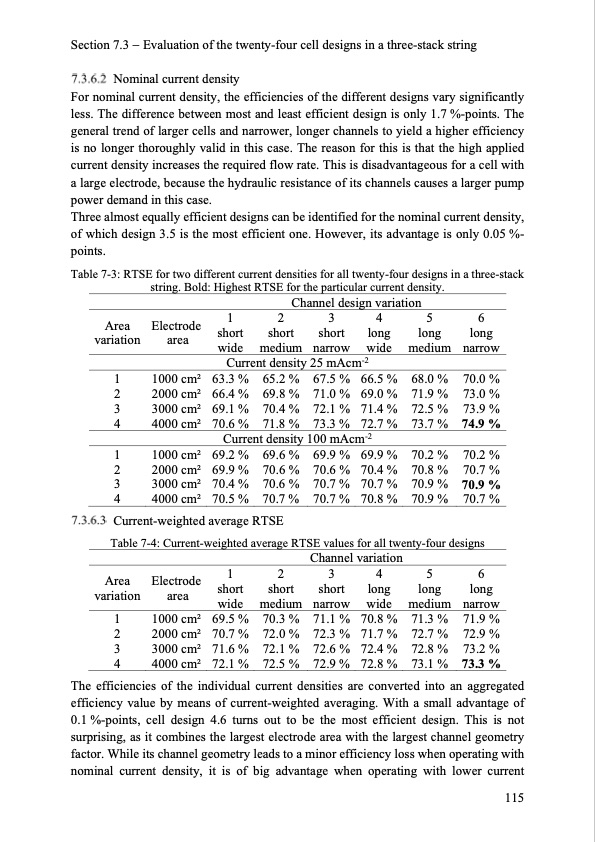
PDF Publication Title:
Text from PDF Page: 123
Section 7.3 Evaluation of the twenty-four cell designs in a three-stack string Nominal current density For nominal current density, the efficiencies of the different designs vary significantly less. The difference between most and least efficient design is only 1.7 %-points. The general trend of larger cells and narrower, longer channels to yield a higher efficiency is no longer thoroughly valid in this case. The reason for this is that the high applied current density increases the required flow rate. This is disadvantageous for a cell with a large electrode, because the hydraulic resistance of its channels causes a larger pump power demand in this case. Three almost equally efficient designs can be identified for the nominal current density, of which design 3.5 is the most efficient one. However, its advantage is only 0.05 %- points. Table 7-3: RTSE for two different current densities for all twenty-four designs in a three-stack string. Bold: Highest RTSE for the particular current density. Area Electrode Channel design variation 123456 short short short long long long wide medium narrow wide medium narrow Current density 25 mAcm-2 63.3% 65.2% 67.5% 66.5% 68.0% 70.0% 66.4% 69.8% 71.0% 69.0% 71.9% 73.0% 69.1% 70.4% 72.1% 71.4% 72.5% 73.9% 70.6% 71.8% 73.3% 72.7% 73.7% 74.9% Current density 100 mAcm-2 69.2% 69.6% 69.9% 69.9% 70.2% 70.2% 69.9% 70.6% 70.6% 70.4% 70.8% 70.7% 70.4% 70.6% 70.7% 70.7% 70.9% 70.9% 70.5% 70.7% 70.7% 70.8% 70.9% 70.7% variation area 1 1000 cm2 2 2000 cm2 3 3000 cm2 4 4000 cm2 1 1000 cm2 2 2000 cm2 3 3000 cm2 4 4000 cm2 Current-weighted average RTSE Table 7-4: Current-weighted average RTSE values for all twenty-four designs Channel variation Area Electrode 123456 short short short long long long wide medium narrow wide medium narrow 69.5% 70.3% 71.1% 70.8% 71.3% 71.9% 70.7% 72.0% 72.3% 71.7% 72.7% 72.9% 71.6% 72.1% 72.6% 72.4% 72.8% 73.2% 72.1% 72.5% 72.9% 72.8% 73.1% 73.3% variation area 1 1000 cm2 2 2000 cm2 3 3000 cm2 4 4000 cm2 The efficiencies of the individual current densities are converted into an aggregated efficiency value by means of current-weighted averaging. With a small advantage of 0.1 %-points, cell design 4.6 turns out to be the most efficient design. This is not surprising, as it combines the largest electrode area with the largest channel geometry factor. While its channel geometry leads to a minor efficiency loss when operating with nominal current density, it is of big advantage when operating with lower current 115PDF Image | Model-based Design Vanadium Redox Flow Batteries

PDF Search Title:
Model-based Design Vanadium Redox Flow BatteriesOriginal File Name Searched:
10-5445IR1000070670.pdfDIY PDF Search: Google It | Yahoo | Bing
Salgenx Redox Flow Battery Technology: Salt water flow battery technology with low cost and great energy density that can be used for power storage and thermal storage. Let us de-risk your production using our license. Our aqueous flow battery is less cost than Tesla Megapack and available faster. Redox flow battery. No membrane needed like with Vanadium, or Bromine. Salgenx flow battery
| CONTACT TEL: 608-238-6001 Email: greg@salgenx.com | RSS | AMP |